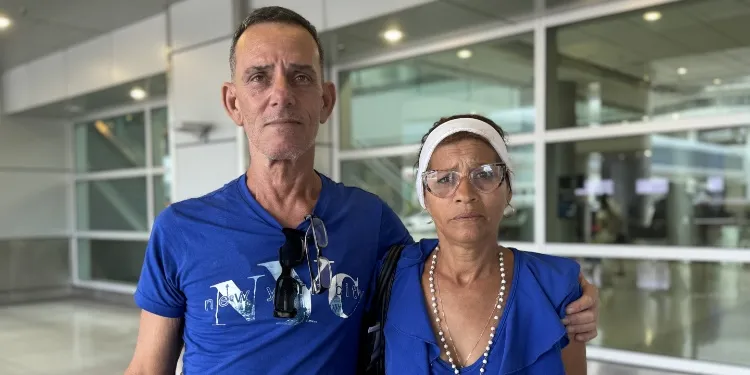He Cites ‘a Lot of Torture That Has Been Done to Me’
Can a President Really Control Prices? Depends
Short Takes: Ava DuVernay at IRE; pharmacies in Black and Hispanic neighborhoods; lawsuit over discriminatory discipline practices; settlement over “When They See Us,” “African Americans and D-Day.”
Homepage photo: Cuban journalist Lázaro Yuri Valle Roca and his wife, Eralidis Frómeta (Credit: CubaNet)
The independent journalist and Cuban political prisoner Lázaro Yuri Valle Roca was exiled by the Cuban regime after having been imprisoned for almost three years. (Credit: YouTube) (in Spanish)
He Cites ‘a Lot of Torture That Has Been Done to Me’
“Lázaro Yuri Valle Roca, a Cuban independent journalist who had been imprisoned in Cuba since 2021 because of his reporting, was released Wednesday on the condition that he leave the island for exile in the United States,” Nora Gamez Torres reported for the Miami Herald.
Valle Roca, arriving at Miami International Airport, said he was headed to Philadelphia, where he and his wife, Eralidis Frómeta, who was with him Wednesday and helped arrange his release, will join his family.
“ ‘There has been a lot of torture that they have done to me,’ said Valle Roca, who apologized to reporters for the state of confusion in which he found himself after leaving the Combinado del Este in Havana, the largest Cuban prison,” the website CiberCuba reported.
“ ‘They have a lot of hatred against me,’ added the independent journalist who spent three years behind bars.
 “Valle Roca explained that the animosity towards him is accentuated by his origins. Nephew of the opposition leader Vladimiro Roca, who died last year, and grandson of the communist leader Blas Roca Calderío, the opponent believes that the regime’s cruelty against him comes, in part, from what he and his family represent.” (Map credit: Human Rights Watch)
“Valle Roca explained that the animosity towards him is accentuated by his origins. Nephew of the opposition leader Vladimiro Roca, who died last year, and grandson of the communist leader Blas Roca Calderío, the opponent believes that the regime’s cruelty against him comes, in part, from what he and his family represent.” (Map credit: Human Rights Watch)
The Herald reported, “Human-rights organizations estimate that Cuba is holding about 1,000 political prisoners. The United States, the European Union and the Catholic Church have all made diplomatic efforts to convince the Cuban government to release at least some, to no avail.
“It is unclear if Valle Roca’s release is an isolated event or a signal that Cuban authorities are changing their calculus on the matter. In the past, they have used political prisoners as bargaining chips to negotiate better relations with the U.S. or the EU.
“U.S. diplomats have said Cuba’s reluctance to release the political prisoners is the most important obstacle to better relations between the two countries. . . .”
CiberCuba continued, via translation, “Valle Roca confirmed that it was a forced exile and that it was clear in how they spoke to him that if he returned to the island he would not survive.
“Last Monday he was transferred from the Combinado del Este to the Prison Room of the National Hospital under ‘maximum security’ measures.
“He says that in the hospital he felt treated like ‘a dangerous terrorist.’ At four in the morning on Wednesdays, State Security agents took him to the José Martí International Airport, where his wife was waiting for him with clothes to change and travel.
” ‘Right now the biggest enemy that Cuba and the Cuban Government have is themselves, because they are so corrupt and the corruption is so deep… We are talking about generals, colonels…’ , assured with conviction the reporter, who since he was a child He rubbed shoulders with the most important families of the Cuban leadership, especially with Raúl Castro’s clan.
“Regarding the moment he was arrested in June 2021, he says that they took him to Villa Marista and that he immediately stood up and went five days without drinking water.
“ ‘There my kidneys exploded, my pressure went to a million, and I am grateful that people went out on July 11 and 12 to the streets, that was what kept me alive, that was what made me quit.’ of the state of starvation,’ he explained.
“He specified that although his destiny was not to die, he has gone through significant physical deterioration in the last three years, a wear and tear from which he will now have to recover little by little. . . .
“Valle Roca obtained a humanitarian parole managed by his wife at the United States Embassy in Havana, a condition imposed by the Government to release him in exchange for exile.
The Herald reported, “Valle Roca was arrested in June 2021 after reporting on a protest in Old Havana in which human rights activists threw leaflets with phrases by Cuban independence leaders José Martí and Antonio Maceo. He was sentenced to five years in prison, accused of disseminating ‘enemy propaganda’ and ‘resisting authorities.’ “
Normando Hernandez, director of the Cuban Institute for Freedom of Expression and the Press, “said Valle Roca arrived in the U.S. with a humanitarian parole after Cuban state security officials informed his wife that the authorities would be willing to release him if he left the country for good.
“ ‘The negotiations took several months, and the U.S. embassy in Havana facilitated his departure,’ Hernandez said. ‘It was difficult because Yuri didn’t want to leave at first. We are deeply happy about his release; he was a journalist who was unjustly imprisoned, but we repudiate the conditions for his release. It is an exile.’ ”
Human Rights Watch says on its website, “The Cuban government continues to repress dissent and deter public criticism. It routinely relies on long and short-term arbitrary detention to harass and intimidate critics, independent activists, artists, protesters, and others. Hundreds of government critics remain behind bars, including many who participated in the landmark July 2021 demonstrations.
“The US embargo continues to provide the Cuban government with an excuse for its problems, a pretext for its abuses, and a way to garner sympathy abroad with governments that might otherwise have been willing to condemn the country’s repressive practices more vocally.”
Katherine Jacobsen, U.S., Canada and Caribbean program coordinator for the Committee to Protect Journalists, said, “Although we welcome Lázaro Yuri Valle Roca’s prison release, it is disconcerting that the Cuban government has forced Valle into exile rather than allowing him to do his job. The Cuban government should allow journalists to work freely, without fear of imprisonment or forced exile.”
- 14ymedio: Five Years in Prison for a Cuban Proposing Elections (July 30, 2022)
- René Gómez Manzano, CubaNet: In Cuba they free a journalist and further oppress the press (June 7)
- Journal-isms: U.S. Media Downplay Threats to Latin Colleagues (June 11, 2022)
- PEN International: Cuba: Journalist Lázaro Yuri Valle Roca released and forcibly exiled (June 12)
Can a President Really Control Prices? Depends
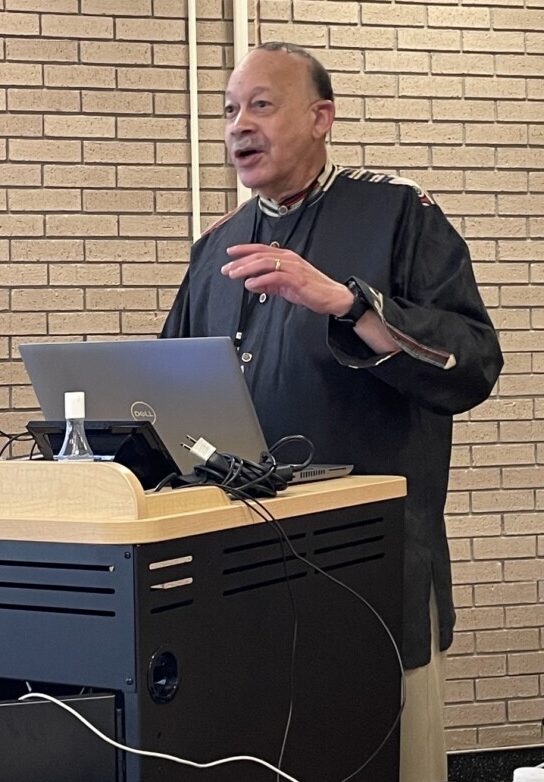 It’s become conventional wisdom that voters believe the economy is ailing, and that President Biden is losing potential supporters as a result, especially among voters of color.
It’s become conventional wisdom that voters believe the economy is ailing, and that President Biden is losing potential supporters as a result, especially among voters of color.
But according to Samuel Myers Jr. (pictured, credit: X), a Black economist at the University of Minnesota’s Humphrey School of Public Affairs, who has joined others to educate younger generations of color to become Ph.D. economists, those voters might be looking for their news in the wrong places.
“There are two issues here,” Myers messaged Journal-isms Thursday:
“a) The fact that the ‘real economics’ is never likely to be explained in the general sections of the media. Instead, it is explained in the business section (depending on whether it is a local or national publication). And, of course, the print media is a declining share of where people get their exposure to economic analysis.
“b) A second big issue is a widening gap since the pandemic between what the economic indicators show (e.g. inflation rates, unemployment rates) and what people believe about these indicators.
“On the first issue, more and more people are getting their economic news from social media vs conventional well-researched print media. On the second issue, the definitions used in the official economic indicators are a half-century old. Yes, egg prices are higher than they were five years ago. But, no, egg prices have not increased over the past few quarters. And, in any event, wages are higher so real egg prices have NOT increased!”
Journal-isms asked Myers how much control presidents have over everyday prices.
“It is typically unusual for presidents to ‘control’ prices,” Myers said. ” Wage-price controls under the Carter Administration are often credited with one of the main sources of public discontent causing Carter to lose [to] Reagan. For more on the hyper-inflation during the Carter years and the policies implemented by Ray Marshall, the Secretary of Labor, see this.“
The article Myers referenced “focuses mostly on wage controls, but one of the main drivers of inflation is the cost of labor,” Myers explained.
“The specific things that presidents can do to affect price changes include import restrictions, currency exchange policies, critical supply management, and public displays of aversion to price increases among regulated companies. So, two points: a) it is possible for a president to affect prices, but b) historically, it has come at a high political cost.”
As for the news media, “The WSJ, The Economist, and usually the NYT provide competent and accurate discussions of the issue of price controls. I am actually surprised that so many price-control initiatives under both Trump and Biden have escaped the typical objections from economic journalists,” referring to the Wall Street Journal and The New York Times.
And a tip: “There are quite a few journalists with degrees in economics (e.g. CNN’s Erin Burnett) so, they know a lot about wage-price controls.”
- Jill Colvin, Associated Press: Tim Scott, a potential Trump VP pick, launches a $14 million outreach effort to minority voters
- Aaron Morrison and Matt Brown, Associated Press: Black leaders call out Trump’s criminal justice contradictions as he rails against guilty verdict
- Sabrina Rodriguez and Hannah Yoon, Washington Post: Young Black voters are key in the 2024 election. Many don’t love their options.
Short Takes
 Award-winning filmmaker Ava DuVernay (pictured) will be the keynote speaker at this year’s conference of Investigative Reporters and Editors, the group said Thursday. “DuVernay will speak in a fireside chat at 4:30 p.m. Saturday, June 22. “For years, Ava DuVernay has championed the important work of investigative journalists and also pushed for improvements in the media industry and in Hollywood,” IRE Board President Brian Rosenthal said in an emailed announcement. “She is an important voice, and we can’t wait for our members to be motivated and inspired by her message.”
Award-winning filmmaker Ava DuVernay (pictured) will be the keynote speaker at this year’s conference of Investigative Reporters and Editors, the group said Thursday. “DuVernay will speak in a fireside chat at 4:30 p.m. Saturday, June 22. “For years, Ava DuVernay has championed the important work of investigative journalists and also pushed for improvements in the media industry and in Hollywood,” IRE Board President Brian Rosenthal said in an emailed announcement. “She is an important voice, and we can’t wait for our members to be motivated and inspired by her message.”
- An “Associated Press analysis of licensing data from 44 states, data from the National Council for Prescription Drug Programs and the American Community Survey shows residents of neighborhoods that are majority Black and Hispanic have fewer pharmacies per capita than people who live in mostly white neighborhoods,” Kenya Hunter reported Tuesday for the Associated Press.
- “On Tuesday, two civil rights organizations filed a federal complaint with the U.S. Department of Education’s Office of Civil Rights against Rockford Public Schools, alleging discriminatory discipline practices,” Peter Medlin reported Tuesday for WNIJ at Northern Illinois University. “The complaint, from the National Center for Youth Law & MacArthur Justice Center, accuses Illinois’ 3rd-largest school district of racially discriminating against its students by over-referring students of color to law enforcement. . . . The federal complaint cites WNIJ’s reporting into the use of expulsions-in-abeyance in Rockford and community protests against school violence, but the station is not involved with the complaint.”
- “Former Manhattan prosecutor Linda Fairstein and Netflix announced Tuesday they’ve settled the defamation lawsuit she filed four years ago over her portrayal in the streaming service’s miniseries about the five Black and Latino teenagers known as the now-exonerated Central Park Five,” the Associated Press reported Tuesday. “Fairstein had argued that the 2019 four-part series ‘When They See Us’ defamed her by portraying her as a racist, unethical villain and attributed actions, responsibilities and viewpoints that were not hers. . . . Ava DuVernay, who directed and co-wrote the series, and Attica Locke, a writer and producer of the series, were named as defendants in the defamation lawsuit. DuVernay said in a statement posted on the social media platform X that she still believes that Fairstein was responsible for the investigation and prosecution of the five teens. . . .”


“A Distant Shore: African Americans on D-Day,” released in 2007, portrayed the role of African American soldiers during the World War II Allied invasion of Normandy.
- “Last weekend, I watched a short (45 minutes) doc called A Distant Shore: African Americans on D-Day,” Roy S. Johnson wrote Thursday for al.com. “The pain of that day, the pain of being deemed not good enough, the pain of what they saw, was in their faces. In their voices. On this day, honor those men by giving it your time (It’s on Hulu.) They were good enough to earn it.”
New WaPo Leaders Pledge More on Diversity
June 4, 2024
After Shakeup, Sharp Questions From Newsroom
Short Takes: Fearless Fund, Black women and DEI; Ginger Thompson; Sam Davis; Rod Carter; BET presidential election special; Cuba and human rights.
Support Journal-ismsDonations are tax-deductible.

Matt Murray speaks to staff members at The Washington Post after being named to a new top editorial role. (Credit: Robert Miller/Washington Post)
After Shakeup, Sharp Questions From Newsroom
The new leaders of The Washington Post, confronted at a newsroom meeting described as “contentious,” “turbulent” and a “shit show” after the surprise exit of Executive Editor Sally Buzbee and the reintroduction of a top layer of white men, promised a “constant commitment” to diversity Monday, a phrase used by Matt Murray, the former Wall Street Journal leader chosen as short-term executive editor.
 “When you were here before, you talked very movingly about how you care about diversity — and people talk about diversity — but then when push comes to shove, they say, ‘Well, I looked around and I couldn’t find anyone,’” star political reporter Ashley Parker (pictured), who is white, said Monday.
“When you were here before, you talked very movingly about how you care about diversity — and people talk about diversity — but then when push comes to shove, they say, ‘Well, I looked around and I couldn’t find anyone,’” star political reporter Ashley Parker (pictured), who is white, said Monday.
“In response, Mr. Murray said that diversity would be a ‘constant commitment’ at The Post, adding that he had ‘the most diverse masthead that The Journal had ever had’ during his years as the top editor at The Wall Street Journal [2018-2023],” Benjamin Mullin and Katie Robertson reported Monday for The New York Times.
“As far as diversity goes,” Charlotte Klein reported for Vanity Fair, Publisher Will Lewis “admitted ‘it’s not great’ and vowed to do better going forward.
“Later in the meeting, another reporter asked Lewis whether ‘any women or people of color were interviewed and seriously considered for either of these positions,’ a question that prompted applause. Lewis said there will be ‘significant opportunities’ within the new organizational structure. . . .”
On Sunday night, the Post announced that Buzbee had stepped down as executive editor. A news release said. ”Buzbee has been with The Washington Post since 2021, leading the newsroom through the turbulence of the pandemic and expanding its service journalism, including Climate and Well+Being. Under her leadership, The Washington Post has won significant awards, including the recent Pulitzer Prize for National Reporting.
“Matt Murray, former Editor in Chief of The Wall Street Journal (WSJ), will replace Buzbee as Executive Editor until the 2024 U.S presidential election, after which Robert Winnett, Deputy Editor of The Telegraph Media Group [in Great Britain], will take on the new role of Editor at The Washington Post, responsible for overseeing our core coverage areas, including politics, investigations, business, technology, sports and features.
“The Washington Post also announced today its intention to launch a new division of the newsroom dedicated to better serving audiences who want to consume and pay for news differently from traditional offerings.
“This third newsroom will be comprised of service and social media journalism and run separately from the core news operation. The aim is to give the millions of Americans – who feel traditional news is not for them but still want to be kept informed – compelling, exciting and accurate news where they are and in the style that they want.”

Matt Murray said that diversity would be a “constant commitment” at The Post. After Election Day, Murray is to shift over to serve as leader of a new company division described as being focused on “service and social media journalism.” (Credit: Robert Miller/Washington Post)
Lewis was hired in November “by Post owner Jeff Bezos with a mandate to reverse a sharp decline in subscriptions and a $77 million deficit over the past year,“ Sarah Ellison, Elahe Izadi and Jeremy Barr reported for the Post Monday, and “wanted to execute the new plan immediately.” Buzbee “balked at the role he saw for her in the new structure — and the two agreed she should depart, according to two people familiar with the conversation. . . .”
Buzbee was the Post’s first female top editor. That the new team leaders are all white men was quickly noted by staffers and outside observers — most prominently by those who were white themselves, and some of whom had attended diversity, equity, inclusion and belonging training at the Post.
Margaret Sullivan, the Post’s former public editor, tweeted Monday, “Each of our three newsrooms will be led by an outstanding white male, which we feel is especially appropriate in Washington DC. If these three newsrooms are successful, we will consider a fourth and fifth.” Sullivan, who now writes for the Guardian, is also executive director of the Craig Newmark Center for Journalism Ethics and Security at the Columbia Journalism School.
The Washington Post Guild said Monday, “We’re troubled by the sudden departure of our executive editor Sally Buzbee and the suggestion from our publisher and CEO Will Lewis that the financial issues plaguing our company span from the work of us as journalists instead of mismanagement from our leadership.
“We are also concerned about the lack of diversity at the top levels of the organization, especially as the Post seeks to reach new audiences while continuing to cover the most pressing issues in the nation and the world.”
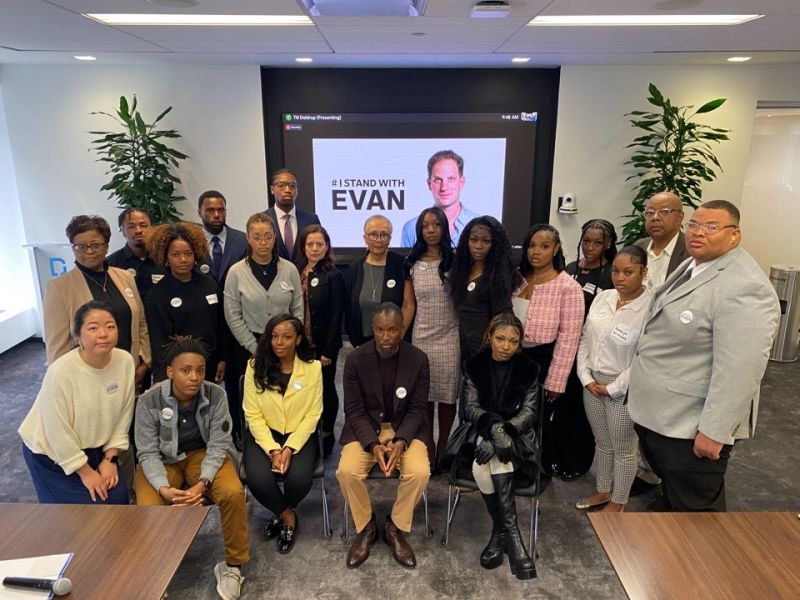
As part of the Wall Street Journal-Morgan State University Business Journalism Exchange Program, the Journal conducted a training session with Morgan State students in former syndicated columnist Leonard Pitts’ Baltimore Reporting Project. Pitts, second from right, in rear, is the director of the university’s Center for Urban Journalism. (Credit: Morgan State University)
In 2020 at the Journal, Murray promoted Brent Jones to a new and expanded masthead role as editor of culture, training and outreach and praised The Wall Street Journal – Morgan State University Business Journalism Exchange Program, “our groundbreaking training collaboration” launched in 2019.
“A second newsroom outreach training initiative, WSJ & Lehman Journo-Tech Program, was announced with CUNY’s Lehman College (Bronx, N.Y.) in February 2020 and is slated to launch remotely this fall. Lehman’s student body is majority Latino,” a Journal news release said then.
In Britain, the news media have been excoriated for insufficient progress on diversity, just as in the United States.
Amid fallout in 2021 over coverage of Prince Harry and Meghan Markle, Duchess of Sussex, Stephen Castle and Isabella Kwai wrote for The New York Times:
“ ‘In terms of the way racism sits in the national debate, Britain is very different from the U.S.,’ said David Yelland, a former editor of the country’s high-selling tabloid, The Sun, and founder of Kitchen Table Partners, a communications company.
“Though he does not agree that race directly motivated the tabloid criticism of Meghan, Mr. Yelland concedes that there is enormous unconscious bias in British newsrooms.
“ ‘In this country we are way behind the U.S. in terms of this being a topic that is on the lips of people all the time,’ he said. ‘There is a huge ignorance of what racism is in this country.’ ”
On its website, Telegraph Media, where incoming Post Executive Editor Robert Winnett worked for 17 years, and where Lewis was his editor, has an extensive section on diversity, inclusion and belonging.
“We believe it’s not only the right thing to do, but that there’s a strong business case to support it. We are focusing on delivering initiatives and programmes which invest in our people, diversify our workforce and enhance everyone’s careers and well-being,” it says.
- Jon Allsop, Columbia Journalism Review: The Brits are coming. Again.
- David Bauder, Associated Press: With its top editor abruptly gone, The Washington Post grapples with a hastily announced restructure
- David Folkenflik, NPR: New CEO of ‘The Washington Post’ puts former colleagues in power
- Matt Fuller and Tara Golshan, NOTUS.org: ‘What the Hell Is Going On?’: Inside The Washington Post After a Surprise Newsroom Shake-Up
- Tom Jones, Poynter Institute: Inside Sally Buzbee’s departure and what’s next for The Washington Post
- Margaret Sullivan, the Guardian: If the Washington Post is to fly again, its journalists must share the cockpit
Update: Additional links (June 6)
- Dylan Byers, Puck: Post’ Mortem: The real and surprising story behind Sally Buzbee’s departure from The Washington Post. (June 5)
- Sarah Ellison and Elahe Izadi, Washington Post: Post publisher draws more scrutiny after newsroom shake-up (June 6)
- Sara Fischer, Axios: Scoop: Former WashPost CEO to host party for outgoing editor Sally Buzbee (June 6)
- David Folkenflik, NPR: ‘Washington Post’ publisher tried to kill a story about him. It wasn’t the first time (June 6)
- Dan Froomkin, Press Watch: Will Lewis must go. The Washington Post publisher’s actions cast doubt on his newsroom’s credibility. (June 6)
- Benjamin Mullin and Katie Robertson, New York Times: Clash Over Phone Hacking Article Preceded Exit of Washington Post Editor (June 5)
- Katie Robertson and Benjamin Mullin, New York Times: Washington Post C.E.O. Promised Interview for Ignoring Scandal, NPR Reporter Says (June 6)
Updated: Additional links (June 7)
- Oliver Darcy, CNN: Morale plummets inside The Washington Post as staffers express alarm over publisher’s attempts to squash story
- Paul Farhi, Daily Beast: Three Strikes So Why Is WaPo CEO Will Lewis Not Out?
- David Folkenflik, NPR: < ‘Washington Post’ CEO tried to kill a story about himself. It wasn’t the first time
- Benjamin Mullin and Katie Robertson, New York Times: Washington Post Leaders Look to Quell Anxiety
- Jack Shafer, Politico: The Growing Debacle for Will Lewis and the Washington Post
- Alexandra Topping and Stephanie Kirchgaessner, the Guardian: Anger mounts at Washington Post over leadership changes and CEO’s record
Short Takes
- “In a closely watched civil rights case, a panel on the 11th Circuit U.S. Court of Appeals blocked Fearless Fund from awarding $20,000 grants to businesses owned by Black women while the case is litigated, siding with conservative activist Edward Blum that the grant program is likely racially discriminatory,” Jessica Guynn reported Monday for USA Today. The appeals court disagreed with a federal judge who ruled in September that the lawsuit was unlikely to prevail on First Amendment grounds. The defeat for the Atlanta firm working to boost scarce venture capital funding for Black women could have sweeping implications for race-based initiatives in the private sector. . . .”
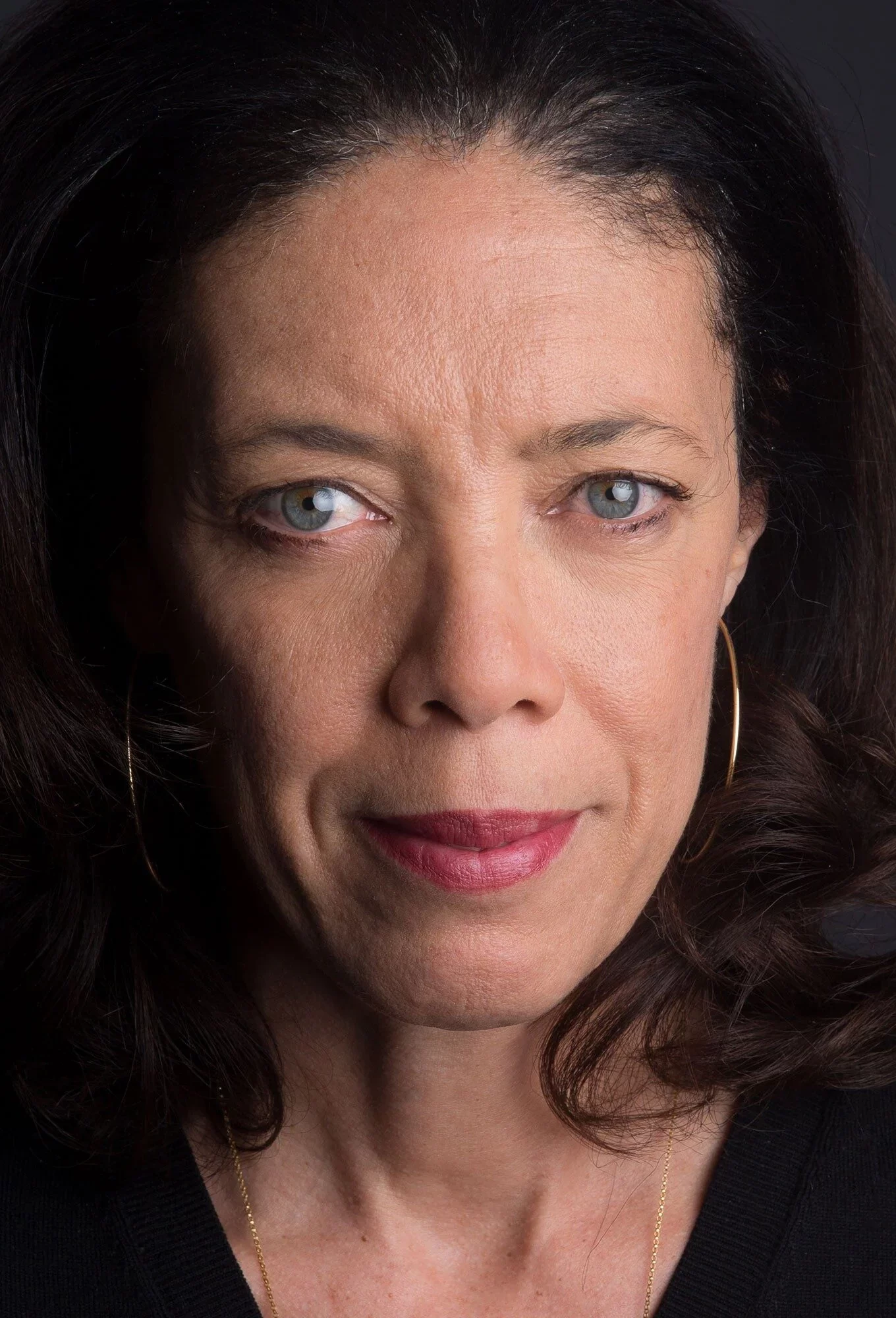 Ginger Thompson (pictured) will be promoted to managing editor at ProPublica, effective immediately, the publication announced. “For the past decade, she has played a key role in our journalism and in shaping our culture — first as a reporter, then as ProPublica’s inaugural chief of correspondents. . . . Thompson joined ProPublica with an extraordinary range of reporting experience. She spent 15 years at The New York Times, where she worked on the investigations team, as a correspondent in Washington and as Mexico City bureau chief. Prior to that she was a Latin America correspondent at the Chicago Tribune and The Baltimore Sun. . . .”
Ginger Thompson (pictured) will be promoted to managing editor at ProPublica, effective immediately, the publication announced. “For the past decade, she has played a key role in our journalism and in shaping our culture — first as a reporter, then as ProPublica’s inaugural chief of correspondents. . . . Thompson joined ProPublica with an extraordinary range of reporting experience. She spent 15 years at The New York Times, where she worked on the investigations team, as a correspondent in Washington and as Mexico City bureau chief. Prior to that she was a Latin America correspondent at the Chicago Tribune and The Baltimore Sun. . . .”
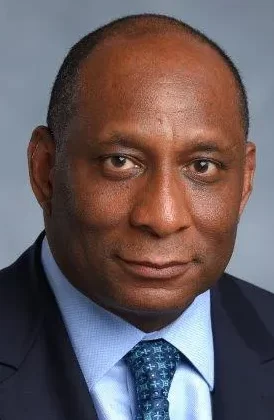 “The Baltimore Sun’s longtime managing editor is retiring and will be replaced by a 24-year veteran of Maryland’s largest news organization, Baltimore Sun Media said Tuesday,” Lorraine Mirabella reported for the Sun Tuesday. “Tricia Bishop, The Sun’s director of opinion and features content since 2019, will take over management of the newsroom later this month from Sam Davis (pictured), who plans to retire from his role at the end of June. Davis, the first Black managing editor in The Sun’s nearly two-century history, started working for the newspaper in 1980. . . . “
“The Baltimore Sun’s longtime managing editor is retiring and will be replaced by a 24-year veteran of Maryland’s largest news organization, Baltimore Sun Media said Tuesday,” Lorraine Mirabella reported for the Sun Tuesday. “Tricia Bishop, The Sun’s director of opinion and features content since 2019, will take over management of the newsroom later this month from Sam Davis (pictured), who plans to retire from his role at the end of June. Davis, the first Black managing editor in The Sun’s nearly two-century history, started working for the newspaper in 1980. . . . “
- “Vivek Ramaswamy’s recent acquisition of a nearly 10 percent stake in BuzzFeed is prompting unexpected questions about the digital media company’s future and feeding speculation around the firebrand conservative’s next moves,” Dominick Mastrangelo and Julia Shapero reported Sunday for The Hill. “Ramaswamy, an investor who made a name for himself as a GOP presidential candidate by embracing conspiracy theories and enthusiastically backing former President Trump, is pitching a new right-wing slant for the digital publisher. But experts and observers in the tech and media sectors say Ramaswamy’s power will be limited, despite a splashy investment in BuzzFeed to keep his name in the news and hold on to relevance as he hopes to get a Republican vice-presidential nomination. . . .”
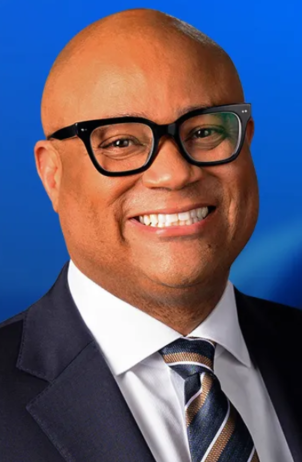 Rod Carter (pictured), weeknight evening anchor at WNCN-TV in Raleigh, N.C., has been appointed to the board of directors of the National Association of Black Journalists, NABJ announced Tuesday. Carter is a former NABJ board member and chairs the NABJ 50th Anniversary Committee. He succeeds Madison Carter, an anchor and investigative journalist at WSOC-TV in Charlotte, N.C., “who will no longer serve on the Board due to NABJ constitutional and operating procedures guideline adherence,” a statement said without elaboration. [Spokesperson Kanya Stewart messaged Wednesday, “At this time, the information that is available to share is in the statement.”]
Rod Carter (pictured), weeknight evening anchor at WNCN-TV in Raleigh, N.C., has been appointed to the board of directors of the National Association of Black Journalists, NABJ announced Tuesday. Carter is a former NABJ board member and chairs the NABJ 50th Anniversary Committee. He succeeds Madison Carter, an anchor and investigative journalist at WSOC-TV in Charlotte, N.C., “who will no longer serve on the Board due to NABJ constitutional and operating procedures guideline adherence,” a statement said without elaboration. [Spokesperson Kanya Stewart messaged Wednesday, “At this time, the information that is available to share is in the statement.”]
- BET is planning to shine a light on the upcoming presidential election, with what it hopes will be a series of primetime election specials,” the Hollywood Reporter reported. “The first of those specials, ‘What’s At Stake: 2024 Election Special,’ will debut June 4 at 10 p.m., on BET, BET Her, and VH1. The special will be hosted by BET correspondent Ed Gordon, and will feature a roundtable discussion with Rep. Maxine Waters (D-CA), Rep. Joyce Beatty (D-OH), and Rep. Jasmine Crockett (D-TX), all members of the Congressional Black Caucus.”
 “Six UN rapporteurs urged the Cuban Government to explain the human rights violations linked to police repression and the judicial processes derived from the protests of July 11, 2021 (11J), the largest in decades on the island, the EFE news agency reported Tuesday. “The letter, sent to Cuban President Miguel Díaz-Canel, and to which the EFE agency had access, argues that if the allegations were confirmed, ‘numerous international human rights norms and standards’ would have been violated. The rapporteurs rely on ‘sufficiently reliable’ information to request ‘immediate attention’ to the matter. . . .” In a 16-page letter dated April 3, the rapporteurs want Cuba to ‘guarantee the rights of peaceful assembly, association and expression without fear of reprisals,’ among other demands. “The letter includes a summary of the information that triggered the procedure, which speaks of ‘hundreds of thousands’ of protesters on July 11, 2021, the violent dissolution of the marches, and the arrest of between 5,000 and 8,000 people in the days that followed. . . .” Journalists were among those arrested.
“Six UN rapporteurs urged the Cuban Government to explain the human rights violations linked to police repression and the judicial processes derived from the protests of July 11, 2021 (11J), the largest in decades on the island, the EFE news agency reported Tuesday. “The letter, sent to Cuban President Miguel Díaz-Canel, and to which the EFE agency had access, argues that if the allegations were confirmed, ‘numerous international human rights norms and standards’ would have been violated. The rapporteurs rely on ‘sufficiently reliable’ information to request ‘immediate attention’ to the matter. . . .” In a 16-page letter dated April 3, the rapporteurs want Cuba to ‘guarantee the rights of peaceful assembly, association and expression without fear of reprisals,’ among other demands. “The letter includes a summary of the information that triggered the procedure, which speaks of ‘hundreds of thousands’ of protesters on July 11, 2021, the violent dissolution of the marches, and the arrest of between 5,000 and 8,000 people in the days that followed. . . .” Journalists were among those arrested.
Sexual Abuse of Native Children Was ‘Pervasive’
June 2, 2024
Boarding Schools Were a ‘National Crime Scene’
False AI Images of Trump With Blacks Proliferate
Combs Said to Hit Women While a Howard Student
Wall Street Journal Lays off Multicultural Mix
House Speaker Rejected Address by Kenya’s Leader
AP Updates Some Racial, Criminal Justice Terms
‘People of Color’ Phrase Makes the Front Page
Short Takes: Multi-millions for The 19th; D. Orlando Ledbetter; Robert Samuels and Toluse Olorunnipa; American U’s new j-school dean; Tanya Spencer; Sia Nyorkor; Hakeem Jeffries and Wu-Tang; Hampton U. j-students’ award; stories from Asian American and Pacific Islander families from California; Ta-Nehisi Coates; Asian Americans favor teaching about race; Paula Tutman;
Harris Faulkner; Northwest Asian Weekly; The Black Lens in Spokane, Wash.; Marcia Smith and Stanley Nelson; complaint of Israeli war crimes against journalists; Mexico’s Claudia Sheinbaum; Nicaragua’s Carlos Fernando Chamorro and other persecuted Latin American journaists; Venezuela’s Carlos Julio Rojas; need for free press guarantees in Lesotho.
Support Journal-ismsDonations are tax-deductible.
On the “PBS NewsHour,” Lisa Desjardins spoke with Deborah Parker, chief executive of the National Native American Boarding School Healing Coalition, and Washington Post reporter Dana Hedgpeth, part of the team that reported the boarding school abuse story and a member of the Haliwa-Saponi Tribe of North Carolina. (Credit: PBS NewsHour/YouTube)
Boarding Schools Were a ‘National Crime Scene’
Firsthand accounts “and other evidence documented by The Washington Post reveal the brutality and sexual abuse inflicted upon children who were taken from their families under a systematic effort by the federal government to destroy Native American culture, assimilate children into White society and seize tribal lands,” Sari Horwitz, Dana Hedgpeth, Emmanuel Martinez, Scott Higham and Salwan Georges reported Wednesday for the Post.
“From 1819 to 1969, tens of thousands of children were sent to more than 500 boarding schools across the country, the majority run or funded by the U.S. government. Children were stripped of their names, their long hair was cut, and they were beaten for speaking their languages, leaving deep emotional scars on Native American families and communities. By 1900, 1 out of 5 Native American school-age children attended a boarding school. At least 80 of the schools were operated by the Catholic Church or its religious affiliates.
“The Post investigation reveals a portrait of pervasive sexual abuse endured by Native American children at Catholic-run schools in remote regions of the Midwest and Pacific Northwest, including Alaska.
“At least 122 priests, sisters and brothers assigned to 22 boarding schools since the 1890s were later accused of sexually abusing Native American children under their care, The Post found. Most of the documented abuse occurred in the 1950s and 1960s and involved more than 1,000 children.
“ ‘A national crime scene’ is how Deborah Parker, a citizen of the Tulalip Tribes and the chief executive of the National Native American Boarding School Healing Coalition, described the network of church-run Indian boarding schools.
“ ‘They committed crimes under the cloak,’ said Parker, whose grandmother and other family members were sent to boarding schools. ‘They did it in the name of God.’
“To investigate, The Post examined the work histories of priests named on lists, disclosed by Catholic entities, as having faced a ‘credible claim of sexual abuse.’ Using those lists from dioceses and religious orders, The Post then identified which abusers worked at Indian boarding schools. Reporters also reviewed lawsuits, sworn affidavits, oral histories and thousands of boarding school records, and conducted interviews with former students. . . .”
In a box headlined “How We Reported This Series,” the newspaper said, “Reporters Sari Horwitz, Dana Hedgpeth and Scott Higham and photojournalist Salwan Georges spent a year traveling to eight states. They spent time on reservations and interviewed more than two dozen Indian boarding school survivors who were sexually and physically abused as children.
“Reporters attended one of Interior Secretary Deb Haaland’s ‘The Road to Healing’ events on the Tulalip Tribes’ reservation in Washington state, where they met with and listened to survivors. Reporters also visited the American Indian Records Repository, located about 100 feet underground in limestone caves in Lenexa, Kan.”

This Instagram post by Trump_History45 is captioned, “Donald Trump takes a photograph with his supporters outside of the Fulton County Jail – August 24th, 2023.”
False AI Images of Trump With Blacks Proliferate
“As the U.S. enters its first presidential election in which convincing misinformation can be created by artificial intelligence (AI), supporters of former President Donald Trump are spreading AI-generated images of him posing with Black celebrities, historical figures, and ordinary Black people,” Angelina Hicks and Vani Sanganeria reported Thursday for the New York Amsterdam News.
“Trump backers often used the fake images to illustrate and amplify a genuine trend: polls showing growing, although still modest, support for Trump among Black voters.
“Some of the photos, which can look strikingly real, began as parodies but ended up being used for political persuasion in posts viewed by millions of people. At least one photo was used in a dubious fundraising scheme by a person purporting to be a top Trump advisor.
“The New York Amsterdam News has identified AI-generated images by using a variety of established methods, including running the images through AI image detection tools. Our methods can be found here.
“In 2020, only about 12% of Black voters cast their ballots for Trump, according to exit polls — the lowest among any major ethnic group. But last fall, the New York Times trumpeted a poll conducted with Siena College that found 22% of Black voters in swing states would support Trump this time around. While the results suggest growing support for Trump among Black voters, only 403 Black voters were polled from the six swing states, making it hard to draw firm conclusions.
“The NYT poll was followed by one from NBC News showing that 20% of Black voters would consider supporting Trump, although it included only about 120 Black people.
“Despite their limitations, these polls received widespread attention. Not long after the NYT poll was released, internet personality and conspiracy theorist Dom Lucre, who has 1.2 million followers on X, posted an AI-generated image of Trump marching in a huge crowd of Black men. The caption read, ‘President Trump can’t lose’ because he has “n*” backing him in this election. The post was viewed more than 11 million times. . . .
“In March, Marcia Ann Mims Coppertino, founder of the Coppertino and Associates Consulting Group, posted the AI-generated image featuring the NBC News tweet on Facebook and LinkedIn. According to her website, her organization is a marketing firm and alleges to be a ‘Trump Congressional District Focus Group.’
“Coppertino used the AI-generated image to advertise an alleged fundraising event in Torrance, Calif., for the Trump campaign. . . .”
The Amsterdam News worked in partnership with the OSINT reporting project of the USC Annenberg School for Communication and Journalism.
Separately, “A pair of studies published Thursday in the journal Science offers evidence not only that misinformation on social media changes minds, but that a small group of committed ‘supersharers,’ predominately older Republican women, were responsible for the vast majority of the ‘fake news’ in the period looked at,” Devin Coldewey reported Thursday for TechCrunch.
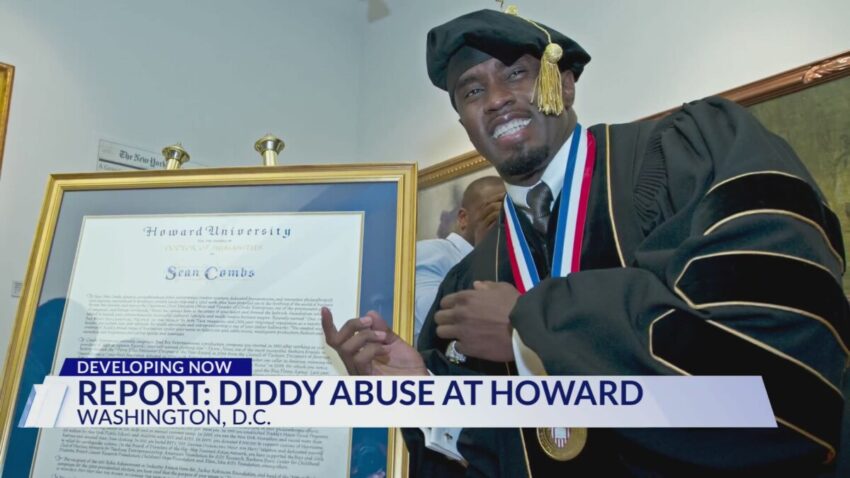
When Sean Combs delivered $1 million to Howard University in October, David P. Bennett, development and alumni relations senior vice president, said, “Mr. Combs has fully honored every public pledge of support he has made to Howard University. . . . Mr. Combs has also supported Howard University and our students in many private ways. This includes through contributions, internships and hiring many Howard alumni at Combs Global.” (Credit: WDVM) (video)
Combs Said to Hit Women While a Howard Student
“Sean ‘Diddy’ Combs’ alleged violence toward women dates back to his days as a student at Howard University in the late 1980s, when the future hip-hop mogul purportedly attacked a girlfriend outside of her dorm, horrifying her classmates and friends, three sources claim to Rolling Stone,” Cheyenne Roundtree (first photo, below) and Nancy Dillon (second photo, below) reported Wednesday in an 11,625-word piece in Rolling Stone.
 “Combs allegedly screamed in a ‘belligerent’ manner for the young woman to come outside, and began hitting her with what appeared to be a belt when she emerged, according to one eyewitness. ‘She was trying to defend herself a little bit,’ the eyewitness says. ‘She was crying. And we were telling him, “Get off of her.” We were screaming for her.’ (The woman at the center of the alleged attack declined to speak with Rolling Stone.)
“Combs allegedly screamed in a ‘belligerent’ manner for the young woman to come outside, and began hitting her with what appeared to be a belt when she emerged, according to one eyewitness. ‘She was trying to defend herself a little bit,’ the eyewitness says. ‘She was crying. And we were telling him, “Get off of her.” We were screaming for her.’ (The woman at the center of the alleged attack declined to speak with Rolling Stone.)
“When reached for comment, Combs did not specifically address the new allegation. ‘Mr. Combs cannot comment on settled litigation, will not comment on pending litigation, and cannot address every allegation picked up by the press from any source, no matter how unreliable,’ his lawyer, Jonathan Davis, tells Rolling Stone. ‘We are aware that the proper authorities are conducting a thorough investigation and therefore have confidence any important issues will be addressed in the proper forum, where the rules distinguish facts from fiction.’
 “The previously unreported incident was part of a six-month Rolling Stone investigation into the Bad Boy Entertainment founder. The career-spanning article, published Tuesday and including interviews with more than 50 people, also uncovered new details of alleged physical aggression inside Bad Boy’s offices and claims that Combs sexually harassed a business associate at a party he threw to celebrate his 2001 acquittal in a nightclub shooting. . . .
“The previously unreported incident was part of a six-month Rolling Stone investigation into the Bad Boy Entertainment founder. The career-spanning article, published Tuesday and including interviews with more than 50 people, also uncovered new details of alleged physical aggression inside Bad Boy’s offices and claims that Combs sexually harassed a business associate at a party he threw to celebrate his 2001 acquittal in a nightclub shooting. . . .
“The new claims bolster the public allegations made against Combs in the six sex-assault lawsuits filed by five women and one man after R&B singer Casandra ‘Cassie’ Ventura stepped forward with her bombshell sex-trafficking lawsuit last November. Several people who spoke to Rolling Stone described Combs as a serial predator who used his fame, fortune, industry status, and reputation as a fun-loving party host to hide a volatile temper and disturbing, narcissistic behavior for decades. . . .”
Combs has been given an honorary doctorate at Howard, donated $1 million to the university and been a commencement speaker.
“Howard University is ‘reviewing’ allegations made against former student and rapper Sean ‘Diddy’ Combs, according to a source with the university, as pressure mounts for the school to revoke the star’s honorary doctorate degree, WDVM-TV in Hagerstown, Md., reported Friday.
- Theresa Braine, Daily News, New York: Sean Combs allegedly beat record executive for dating ex Kim Porter: report
- Ida Harris, Madame Noire: ‘They All Knew:’ Diddy’s Violent Pedigree Ain’t Nothing New To These Nilgrims (May 22)
- Jason Newman and Cheyenne Roundtree, Rolling Stone: Notorious B.I.G.’s Mom: ‘I Want to Slap the Daylights Out of Sean Combs’
- Justin Rohrlich and AJ McDougall, Daily Beast: New Diddy Accuser Describes His ‘Adolescent’ Penis in Graphic Lawsuit
- Elizabeth Wagmeister and Josh Campbell, CNN: Exclusive: A federal grand jury may soon hear from Sean ‘Diddy’ Combs’ accusers
Wall Street Journal Lays off Multicultural Mix
The Wall Street Journal laid off a multicultural group of at least eight more employees on Thursday with the U.S. news and “speed and trending” teams affected, “two people familiar with the matter” told Daniel Lippman of Politico, who reported the news Friday on X.
 “Layoffs included NYC reporter Erin Ailworth, Midwest staff reporter Ben Kesling, breaking news reporter Suryatapa Bhattacharya (pictured), U.S. news reporter Talal Ansari, reporter Christine Mai-Duc, Texas reporter Adolfo Flores (pictured, below) and mid-U.S. correspondent Shannon Najmabadi, according to the sources,” Politico reported.
“Layoffs included NYC reporter Erin Ailworth, Midwest staff reporter Ben Kesling, breaking news reporter Suryatapa Bhattacharya (pictured), U.S. news reporter Talal Ansari, reporter Christine Mai-Duc, Texas reporter Adolfo Flores (pictured, below) and mid-U.S. correspondent Shannon Najmabadi, according to the sources,” Politico reported.
 At least three have connections to South Asia.
At least three have connections to South Asia.
In addition, Daniel Varghese, who oversaw the gear and gadgets section of Off Duty at The Wall Street Journal, editing stories about personal technology, was among the layoffs at the publication on Thursday,” Chris Roush reported that day for Talking Biz News.
“I had so much fun working with the team at Off Duty, and hope that you all continue to read their work,” he wrote on Twitter. Roush added Alicia A. Caldwell, who covers immigration, on Friday.
David Folkenflik reported Thursday for NPR, “The Wall Street Journal has laid off even more journalists, despite a surge in paid subscribers, strong profits at its parent company, and a new nine-figure licensing deal with OpenAI.
“The union representing the newsroom – the International Association of Publishers’ Employees – staged an hour-long walkout Thursday to object to the job cuts. Staffers stuck Post-it notes protesting the move on the glass walls of the office of Editor in Chief Emma Tucker, whose vision for the paper has come under fire.
“The layoffs of at least eight reporters who covered national and breaking news follow double-digit cuts to staff in Washington and abroad, although the paper has added some positions back in recent months. The union tabulation only covers those represented by the local; others have been laid off as well.
“In a note to staff, Tucker described the moves as part of a larger reorganization.
“ ‘Our Editor-in-chief is reshaping our newsroom with an eye towards digital growth, subscription growth and high-quality journalism,’ a spokesperson said in a written statement. ‘While we recognize change can be difficult, it is necessary to ensure we have the right structure in place to support our objectives.’ ”
- Erin Baldassari, KQED, San Francisco: KQED Cuts 34 Positions Amid Budget Shortfall (May 23)
- Adrienne Broaddus, NBC News: Minnesota Timberwolves follow the lead of their diversity and inclusion executive
- Katalina Deaven, Center for Media Engagement: Research: Journalist race, ethnicity in bylines show mixed reader preferences
- Laura Flanders, Chenjerai Kumanyika, Neesha Powell-Ingabire, Mary Annaïse Heglar, YouTube: BIPOC Press for the People: Bursting the Corporate Media Bubble
- Lily Ford, Hollywood Reporter: BBC to Review Representation of “Different Groups and Communities” Across Its Content
- Tianna Mañón, Pubic Square Amplified: Newsrooms are stuck in an ongoing cycle of hiring, then firing BIPOC reporters
- Jeroslyn JoVonn, Black Enterprise: How the Black Journalists Therapy Relief Fund Aids Those on the Front Lines of Racial Injustice Reporting
- Katie Robertson, X: WSJ editor Emma Tucker announces changes in how the paper covers US News, including shuttering east coast, Midwest and West Coast regional bureaus
KTN News in Kenya reports on President William Ruto’s four-day trip to the United States, followed by a visit to China by another Kenyan delegation. Ruto told a reporter, “We are neither facing west, nor facing east, we are facing forward.” (Credit: YouTube)
House Speaker Rejected Address by Kenya’s Leader
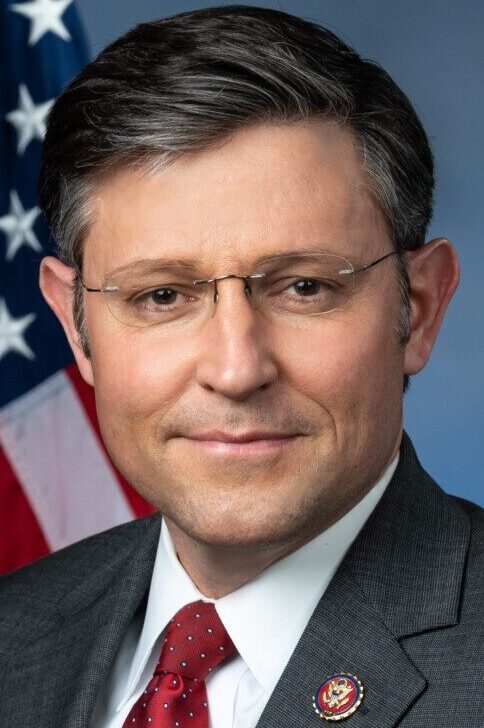 Thumbs up to the news outlets that reported a development on Capitol Hill that many ignored: House Speaker Mike Johnson’s (pictured) rejection of a request for Kenya’s president William Ruto to address a joint session of Congress during his trip to the United States last month.
Thumbs up to the news outlets that reported a development on Capitol Hill that many ignored: House Speaker Mike Johnson’s (pictured) rejection of a request for Kenya’s president William Ruto to address a joint session of Congress during his trip to the United States last month.
Politico’s Nahal Toosi mentioned it May 16 in explaining that “African Countries Are Failing to Make a Dent in Washington’s Diplomatic Scene,” in the words of the headline.
The Hill and USA Today also reported the snub, with The Hill’s Lauren Irwin noting that the Congressional Black Caucus pointed out that such an invitation “is typically extended to other international leaders.”
In fact, Politico’s Jordain Carney reported Friday that “Congressional leaders have officially invited Israeli Prime Minister Benjamin Netanyahu to speak before Congress, capping off weeks of behind-the-scenes negotiations.”
Swapna Venugopal Ramaswamy of USA Today reported May 23, while Ruto was still in Washington, “Ruto’s trip is the first state visit by a Kenyan president to the United States in two decades and the first by an African leader since 2008. The last African leader to address Congress was Liberian President Ellen Johnson Sirleaf who spoke in the House chamber in 2006.
“A letter signed by more than 60 members of the Congressional Black Caucus, including House Minority Leader Hakeem Jeffries, demanded that Ruto be ‘treated with the same respect granted to other heads of state.’
“Recent heads of state including Japanese Prime Minister Fumio Kashida, Indian Prime Minister Narendra Modi, Israeli President Isaac Herzog, and South Korean President Yoon Suk Yeol have all addressed the joint session of Congress.”
Rep. Michael McCaul, R-Texas, chair of the House Foreign Affairs Committee, also filed a request to have Ruto speak in a joint letter with Rep. Gregory Meeks, D-N.Y., a ranking member of the committee, Kenya’s Capital News reported.
“Asked about his decision, Johnson’s office sent a statement to USA TODAY saying ‘scheduling restraints’ were the reason for the lack of invitation.
“We offered the Kenyan embassy over 90 minutes of engagement including a one-on-one visit with Speaker Johnson, bipartisan leadership meeting with Speaker Johnson, Leader Jeffries, and Committee Chairmen and Ranking Members, and a bicameral meeting,” the statement said of the meeting that took place May 22.
 Ja’han Jones (pictured) wrote May 23 for MSNBC, “Johnson’s snub speaks to what I deem to be an American arrogance or ignorance about African nations’ roles as power brokers, both now and in the future. I felt similarly last year, when then-House Speaker Kevin McCarthy booted Rep. Ilhan Omar, a Minnesota Democrat who’s the only African-born member of the House, from the Foreign Affairs Committee and its subcommittee on Africa.
Ja’han Jones (pictured) wrote May 23 for MSNBC, “Johnson’s snub speaks to what I deem to be an American arrogance or ignorance about African nations’ roles as power brokers, both now and in the future. I felt similarly last year, when then-House Speaker Kevin McCarthy booted Rep. Ilhan Omar, a Minnesota Democrat who’s the only African-born member of the House, from the Foreign Affairs Committee and its subcommittee on Africa.
“Africa has the youngest, fastest-growing population in the world, it’s rich in resources needed to power the high-tech revolution, its leaders are increasingly wary of U.S. imperialism and paternalism, and lately some of its nations have shown openness to cooperating with China and Russia. Now is the time for the U.S. to make serious inroads with Africa — and not presume their leaders will be satisfied with mere sit-downs and photo ops.
“Fortunately, many Democrats, including [President] Biden, seem to have gotten the message. Republicans? Not so much.”
- Nation Africa, Kenya: Speaker Mike Johnson declines US Congress Ruto address request (May 11)
- Reporters Without Borders: The year since Kenyan president’s election marked by new hostility towards media (Sept. 11, 2023)
“Locs is our style for a rope-like hairstyle that is a common protective hairstyle among Black people,” the news cooperative says. (Credit: YouTube).
AP Updates Some Racial, Criminal Justice Terms
The Associated Press Wednesday updated its stylebook with revised entries for “Native Americans,” locs,” the Civil Rights Movement, the difference between “juvenile” and “minor,” who is a Hawaiian, and “LGBT+” among them.
” Updated guidance says to generally use the term Native Americans in broad references when referring to two or more people of different tribal affiliations within the contiguous U.S. geographic boundaries. The term Indigenous people(s) is a broad umbrella term, describing the original inhabitants of a place globally. The term does not capture the political relationship or political status of Native American tribes or people, so use it only when the broad description is accurate. Be specific about a person’s citizenship and/or affiliation. The term American Indians is generally considered outdated. The guidance gives additional detail on these terms and other language considerations.
Also in the race-related coverage entry: new guidance that locs is our style for a rope-like hairstyle that is a common protective hairstyle among Black people. Specify dreadlocks, dreads when referring to people with the hairstyle who are of Jamaican descent or Rastafarian belief. Locks refers to hair in general.
A new entry on the Civil Rights Movement, which should be capitalized when referring to the specific historical period in the U.S. mainly in the 1950s and ’60s.
A change in AP style from LGBTQ to LGBTQ+ to make it more inclusive. Also updates on deadnaming, queer, transgender and other gender-related terms and points.
Expanded guidance on the right and wrong uses of the term Hawaiian(s): “Use the term Hawaii residents — not Hawaiians — for the overall population of Hawaii. Use the term Hawaiian or Hawaiians only for members of the ethnic group indigenous to the Hawaiian Islands. They also may be called Native Hawaiians, Indigenous people in Hawaii or Hawaii’s Indigenous people.”
The revisions also say, “Juvenile and minor are broad terms that can carry legal connotations when sometimes there are none, or those connotations are beside the point. The terms’ clinical tone can inadvertently suggest guilt in situations of crime or conflict. They can be dehumanizing. They can be perceived as having racial connotations. Their definitions can vary across jurisdictions.
“Depending on the context and available information, consider terms like child, teenagers, youths, young teens, etc. Use specific ages or age ranges when possible: 5-year-old girls, not young girls or 15- to 20-year-olds, not youths. Or consider descriptions such as children and young teens (if accurate).
“When possible, ask sources who use the terms juvenile or minor for specifics on what they mean, then use those specifics rather than the general term. . . .”
And a word about the media: “Revised entry recommends avoiding writing in a way that implies media are monolithic. Be specific when referring to, for example, news media, social media or paid media. Refer to specific organizations or companies individually when relevant.”

‘People of Color’ Phrase Makes the Front Page
There it was, “People of Color” on the front page of Wednesday’s Washington Post.
It was in 2020 that the National Association of Hispanic Journalists came out against the term “minorities,” as did columnist Derrick Z. Jackson, then at the Boston Globe, in 1991.
Stull, not everyone is sold on “people of color,” or, for that matter, any of the other terms.
NAHJ called minorities “a word that for too long has perpetuated an ‘us vs. them’ narrative,” among other shortcomings.
Some on Facebook said “people of color” erases Black people, or was too close to the outdated “colored people.”
A Latino journalist wrote there, “I like the term ‘people of color.’ I don’t use the word ‘minority’ to describe Latinos. As for BIPOC, that term minimizes Latinos to the point of just adding us as one of many groups. It’s like putting Latinos as secondary and not equals. We are an ‘And’ with a bunch of other people of color. That word to me means Blacks, indigenous and ‘other.’
“It would be as wrong as using LIPOC, Latinos, Indigenous and other people of color.”
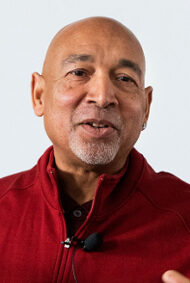 Jackson (pictured) wrote, “I feel more strongly than ever that people of color should not refer to ourselves in any kind of ‘minor key.’ We are the majority or close to it in many realms that matter in U.S. society. Kids of color are now the majority of public school students. Commuters of color are now the majority of users of public transportation. People of color are the majority of US Army recruits. And we don’t need to ask twice who is the majority backbone of NFL, NBA, WNBA, or the Power 5 conferences in college football & basketball. Again, the very first definition of ‘minor’ in Merriam-Webster’s is: ‘inferior in importance, size, or degree : comparatively unimportant.’ “
Jackson (pictured) wrote, “I feel more strongly than ever that people of color should not refer to ourselves in any kind of ‘minor key.’ We are the majority or close to it in many realms that matter in U.S. society. Kids of color are now the majority of public school students. Commuters of color are now the majority of users of public transportation. People of color are the majority of US Army recruits. And we don’t need to ask twice who is the majority backbone of NFL, NBA, WNBA, or the Power 5 conferences in college football & basketball. Again, the very first definition of ‘minor’ in Merriam-Webster’s is: ‘inferior in importance, size, or degree : comparatively unimportant.’ “
A Post spokesperson told Journal-isms, “The Washington Post tends to follow The Associated Press’s lead on the phrase.”
That lead, part of the post-George Floyd revisions of September 2020, says, “The term is acceptable when necessary in broad references to multiple races other than white: We will hire more people of color. Nine playwrights of color collaborated on the script.
“Be aware, however, that many people of various races object to the term for various reasons, including that it lumps together into one monolithic group anyone who isn’t white.
“Be specific whenever possible by referring to, for instance, Black Americans, Chinese Americans or members of the Seminole Tribe of Florida. Examples: The poll found that Black and Latino Americans are bearing the brunt of the pandemic’s financial impact, not people of color are bearing the brunt of the pandemic’s financial impact. Most of the magazine’s readers are Black women, not most of the magazine’s readers are women of color.
“In some cases, other wording may be appropriate. Examples: people from various racial and ethnic backgrounds; diverse groups; various heritages; different cultures.
“Do not use person of color for an individual.
“Do not use the term Black, Indigenous and people of color, which some see as more inclusive by distinguishing the experiences of Black and Indigenous people but others see as less inclusive by diminishing the experiences of everyone else. Similarly, do not use the term Black, Asian and minority ethnic. Do not use the shorthand POC, BIPOC or BAME unless necessary in a direct quotation; when used, explain it.”
- The front-page story: Akilah Johnson, Washington Post: In communities of color, long-covid patients are tired of being sick and neglected
Short Takes
- “Melinda French Gates has given a three-year, multi-million dollar grant to nonprofit newsroom The 19th, the outlet announced Tuesday,” Natalie Korach reported for The Wrap. “The grant will allow 19th, which reports at the intersection of gender, politics, and policy, to expand its public service journalism and sustain operations. The grant is part of French Gates’ $1-billion strategic initiative directed toward organizations that advance women’s rights. . . .”
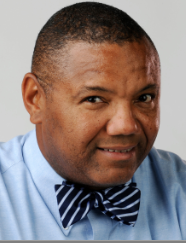 “D. Orlando Ledbetter (pictured), Falcons Beat Writer for The Atlanta Journal-Constitution, won the Bill Nunn Memorial Award that is given annually by the Professional Football Writers of America to a reporter for ‘long and distinguished contribution to pro football through coverage.’ “Ledbetter has covered the Atlanta Falcons for the Atlanta Journal-Constitution since 2006. He has covered the Michael Vick dog-fighting case, Bobby Petrino’s less than one season tenure and the Falcons’ Super Bowl appearance in 2016. Ledbetter also helped cover the Bengals for the Cincinnati Enquirer and Packers for the Milwaukee Journal and Milwaukee Journal Sentinel. He is a member of the Pro Football Hall of Fame’s Selection Committee representing Atlanta and is part of the Seniors Selection Committee. He is a past winner of Georgia Sportswriter of the Year by the National Sportscasters and Sportswriters Association and a past president of the Professional Football Writers of America,” the football writers organization said.
“D. Orlando Ledbetter (pictured), Falcons Beat Writer for The Atlanta Journal-Constitution, won the Bill Nunn Memorial Award that is given annually by the Professional Football Writers of America to a reporter for ‘long and distinguished contribution to pro football through coverage.’ “Ledbetter has covered the Atlanta Falcons for the Atlanta Journal-Constitution since 2006. He has covered the Michael Vick dog-fighting case, Bobby Petrino’s less than one season tenure and the Falcons’ Super Bowl appearance in 2016. Ledbetter also helped cover the Bengals for the Cincinnati Enquirer and Packers for the Milwaukee Journal and Milwaukee Journal Sentinel. He is a member of the Pro Football Hall of Fame’s Selection Committee representing Atlanta and is part of the Seniors Selection Committee. He is a past winner of Georgia Sportswriter of the Year by the National Sportscasters and Sportswriters Association and a past president of the Professional Football Writers of America,” the football writers organization said.
- Washington Post reporters Robert Samuels and Toluse Olorunnipa, authors of the Pulitzer Prize-winning “His Name is George Floyd,“ reflected May 25 on the retrenchment of the racial-justice movement sparked by his death. Samuels said, “Over the course of our reporting, I came to believe this: Pessimism is the ultimate American privilege. It is the feeling held most easily by those whose lives would still be functional, and maybe even satisfactory, if nothing changed. And it is the feeling so often rejected by those who have the least, who, like George Floyd, wake up each day in hopes that a better tomorrow might be possible. This form of American hope was a defense mechanism, but it was also an engine that kept them engaged in the world. . . .”
 Marnel Niles Goins (pictured), most recently the dean of the College of Sciences and Humanities and professor of Communication at Marymount University, is the new dean of American University’s School of Communication, American announced May 7. She succeeds Sam Fulwood III, who resigned in May 2023. “Under her stellar leadership, the college established four new majors and one school, improved retention and enrollment, and increased fundraising and scholarship production,” a news release said. She starts July 1.
Marnel Niles Goins (pictured), most recently the dean of the College of Sciences and Humanities and professor of Communication at Marymount University, is the new dean of American University’s School of Communication, American announced May 7. She succeeds Sam Fulwood III, who resigned in May 2023. “Under her stellar leadership, the college established four new majors and one school, improved retention and enrollment, and increased fundraising and scholarship production,” a news release said. She starts July 1.
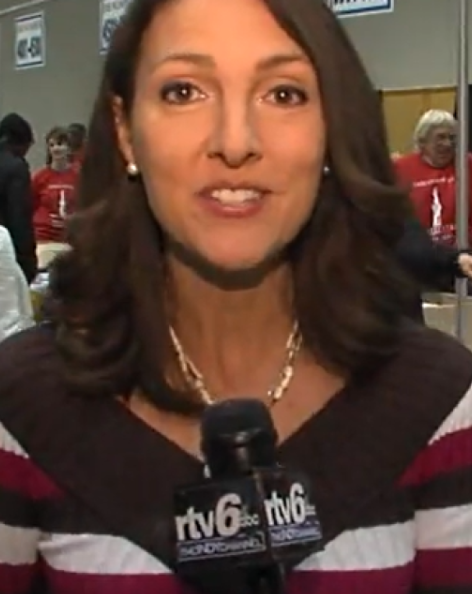 “Former WRTV anchor Tanya Spencer (pictured) has died after battling an aggressive cancer which started in her colon,” Kara Kenney reported May 25 for WRTV in Indianapolis. “She was 53 years old. Tanya Sumner, known as Tanya Spencer during her television reporting career, also served District Three on the Whitestown Town Council. She died at her home on May 24. Tanya spent 10 of her 20 years in television journalism as a reporter and anchor at WRTV. . . .”
“Former WRTV anchor Tanya Spencer (pictured) has died after battling an aggressive cancer which started in her colon,” Kara Kenney reported May 25 for WRTV in Indianapolis. “She was 53 years old. Tanya Sumner, known as Tanya Spencer during her television reporting career, also served District Three on the Whitestown Town Council. She died at her home on May 24. Tanya spent 10 of her 20 years in television journalism as a reporter and anchor at WRTV. . . .”
 “Cleveland 19 News anchor-reporter Sia Nyorkor (pictured) is leaving the station. The Indianapolis native announced this will be her last week at the local CBS affiliate,” Joey Morona reported Wednesday, updated Friday, for cleveland.com. Nyorkor is also parliamentarian of the National Association of Black Journalists. “Nyorkor arrived in Cleveland in 2015 and helped launch the station’s weekend morning newscast in 2019,” Morona wrote. “Her reporting at WOIO has won multiple awards, and she’s become one of the most recognizable local TV news personalities, often interacting with viewers at community events and on social media, as well as volunteering at St. Augustine Hunger Center in Tremont. . . .”
“Cleveland 19 News anchor-reporter Sia Nyorkor (pictured) is leaving the station. The Indianapolis native announced this will be her last week at the local CBS affiliate,” Joey Morona reported Wednesday, updated Friday, for cleveland.com. Nyorkor is also parliamentarian of the National Association of Black Journalists. “Nyorkor arrived in Cleveland in 2015 and helped launch the station’s weekend morning newscast in 2019,” Morona wrote. “Her reporting at WOIO has won multiple awards, and she’s become one of the most recognizable local TV news personalities, often interacting with viewers at community events and on social media, as well as volunteering at St. Augustine Hunger Center in Tremont. . . .”
- “I recently ran into House Democratic Leader Hakeem Jeffries in D.C.,” John Heilemann wrote Monday for Puck, “and mentioned a clip I’d caught somewhere on social media of him being asked by a California TV anchor to name his favorite rap lyric — causing Jeffries to uncork a smooth, word-perfect rendition of a few bars of Wu-Tang’s ‘C.R.E.A.M.,’ which is, FYI and FWIW, undeniably one of the greatest tracks in the history of hip-hop. Well, the aforementioned interviewer heard the pod and shot me a nice email, so credit where due to Elex Michaelson, Fox 11 Los Angeles anchor and host of The Issue Is, the TV show and podcast on which Jeffries turned in his Wu homage. And, of course, props to Hakeem himself, who beamed with pride, and rightly so, when I mentioned how tight it was… as you can see for yourself here.
- Students at Hampton University won first place in the Hearst Journalism Awards Program. The category was “Investigative Reporting Individual or Team Competition,” the program announced May 20. “There were 72 entries from 43 schools submitted in the fifth and final writing competition of the academic year.” Team members were Daelin Brown, Jordin Wright, Tigist Ashaka, Sherdell Baker, Sydney Broadnax, Noah Hogan and Mikayla Roberts. “They will receive a $3,000 scholarship for the winning article ‘In Portsmouth, a Superfund Site Pollutes a Creek, Threatens a Neighborhood and Defies a Quick Fix’ published in Inside Climate News.
- “A new narrative podcast is attempting to bridge the gap between the personal and the historical by shining a light on the stories of seven Asian American and Pacific Islander families from California,” Marah Eakin wrote Monday for Current. “Inheriting, a production of LAist Studios distributed by the NPR Network, finds Emily Kwong, host of the NPR podcast Short Wave, facilitating conversations between family members about everything from the 1992 Los Angeles uprising to the Imperial Japanese occupation of Guam to what it was like to grow up under the brutal thumb of the Khmer Rouge in Cambodia.
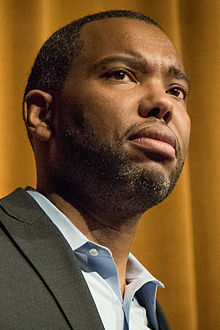 “One World will publish Ta-Nehisi Coates’s The Message, the author’s first all-new nonfiction book in nearly a decade, on October 1,” Publishers Weekly reported Thursday. “The Message incorporates reportage from Palestine, Senegal, and South Carolina — three places that, per the publisher’s announcement, ‘have been profoundly shaped and riven by contested accounts of meaning and reality.’ “
“One World will publish Ta-Nehisi Coates’s The Message, the author’s first all-new nonfiction book in nearly a decade, on October 1,” Publishers Weekly reported Thursday. “The Message incorporates reportage from Palestine, Senegal, and South Carolina — three places that, per the publisher’s announcement, ‘have been profoundly shaped and riven by contested accounts of meaning and reality.’ “
- “U.S. schools should teach about issues related to race, most Asian Americans, Native Hawaiians and Pacific Islanders believe. They also oppose efforts to restrict what subjects can be discussed in the classroom, according to a new poll,” Annie Ma and Linley Sanders reported Wednesday for the Associated Press. “In the survey from AAPI Data and The Associated Press-NORC Center for Public Affairs Research, 71% of AAPI adults favor teaching about the history of slavery, racism and segregation in K-12 public schools. The same share also said they support teaching about the history of Asian American and Pacific Islander communities in the United States, while about half support teaching about issues related to sex and sexuality. . . . “
 “The news of my departure is NOT greatly exaggerated. It is true. Yes, I have accepted a generous buyout offer from my company,” Paula Tutman (pictured) wrote Wednesday for WDIV-TV in Detroit, listing the things she will and will not miss about the job. Tutman has been a reporter with the station since 1992. Bernie Smilovitz, Rod Meloni and Mara MacDonald are also leaving WDIV-TV in early July, WDIV Vice President and General Manager Bob Ellis announced on Tuesday. “The four broadcasters took early voluntary buyouts from the station, and their exit coincides with a number of behind-the-scenes employees who will be leaving the station as well,” Adam Graham reported Wednesday, updated Thursday, for the Detroit News.
“The news of my departure is NOT greatly exaggerated. It is true. Yes, I have accepted a generous buyout offer from my company,” Paula Tutman (pictured) wrote Wednesday for WDIV-TV in Detroit, listing the things she will and will not miss about the job. Tutman has been a reporter with the station since 1992. Bernie Smilovitz, Rod Meloni and Mara MacDonald are also leaving WDIV-TV in early July, WDIV Vice President and General Manager Bob Ellis announced on Tuesday. “The four broadcasters took early voluntary buyouts from the station, and their exit coincides with a number of behind-the-scenes employees who will be leaving the station as well,” Adam Graham reported Wednesday, updated Thursday, for the Detroit News.
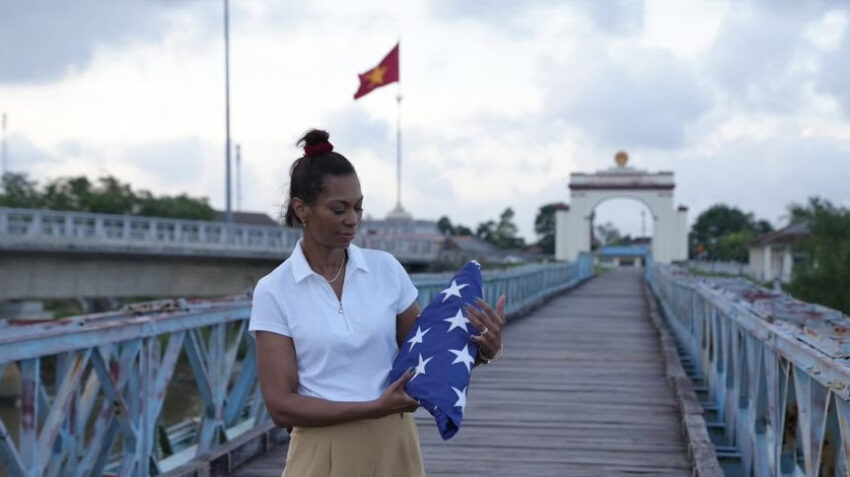
“I know my father wished he could have saved more people,” Harris Faulkner said. “But maybe the silver lining is that we left some things behind. We left who we are imprinted on the people of South Vietnam. And I know that because I’ve been among them.”
- Even before she became a journalist, Fox News host “Harris Faulkner knew the world was bigger than her backyard. The self-described military brat grew up on Army bases at home and abroad following her father, Lieutenant Colonel Bobby Harris, as his military career took their family around the globe, Ethan Alter reported May 24 for TVNewser. “But there was one country that remained a blank spot on Faulkner’s personal map until very recently — Vietnam. Only her father had spent time in the Southeast Asian nation, and it wasn’t a period of his life that he relished revisiting. Harris served three tours of duty during the Vietnam War, two as an Army combat pilot, and rarely talked about the experience with his daughter while she was growing up. Now, Faulkner is making the trip for both of them via the new series, Footsteps of My Father. Streaming on Fox Nation . . . the three-part travelogue finds her retracing the path of Harris’ own soldier’s story through present day Vietnam. . . .”

Assunta Ng, founder and publisher of Northwest Asian Weekly, has sold the 41-year-old newspaper to a group of Seattle-area investors. In this 2023 photo, Ng, center, is shown with, from left, Albert Shen, Sam Cho, Jeffrey Roh and Tim Wang. (Credit: John Liu)
- “After decades of nurturing one of the most influential Asian American community media publications in the Pacific Northwest, Assunta Ng, founder and publisher of the Northwest Asian Weekly, announced its sale to a group of four partners on Friday,” James Tabafunda reported May 24 for Northwest Asian Weekly. “The move comes seven months after Ng and her family donated the publication’s elder sibling, the Seattle Chinese Post, to the Asia Pacific Cultural Center, a Tacoma [Wash.]-based nonprofit focused on cultural exchange. . . . “
 “The Black Lens was founded in 2015 by community activist Sandy Williams, who charmed and cajoled people to provide stories or interviews as she produced it from a spare room in her parents’ home,” Andrew Buncombe wrote for the Guardian May 24 from Spokane, Wash. “When she was among 10 people killed in a plane crash in the Puget Sound in September 2022, along with her partner, Patricia Hicks, there was intense grief. There was also anxiety about what would happen to the newspaper to which she had provided a life force. Williams’s family, several foundations, local businesses, and some journalists from the Spokesman-Review, Spokane’s daily newspaper, have created a non-profit for a project of revival of the Black Lens. Under this model, the community paper will be printed and distributed once a month in the Spokesman-Review. There is money for journalists, and it has its own website. The city’s Gonzaga University plans to provide office space. . . .”
“The Black Lens was founded in 2015 by community activist Sandy Williams, who charmed and cajoled people to provide stories or interviews as she produced it from a spare room in her parents’ home,” Andrew Buncombe wrote for the Guardian May 24 from Spokane, Wash. “When she was among 10 people killed in a plane crash in the Puget Sound in September 2022, along with her partner, Patricia Hicks, there was intense grief. There was also anxiety about what would happen to the newspaper to which she had provided a life force. Williams’s family, several foundations, local businesses, and some journalists from the Spokesman-Review, Spokane’s daily newspaper, have created a non-profit for a project of revival of the Black Lens. Under this model, the community paper will be printed and distributed once a month in the Spokesman-Review. There is money for journalists, and it has its own website. The city’s Gonzaga University plans to provide office space. . . .”
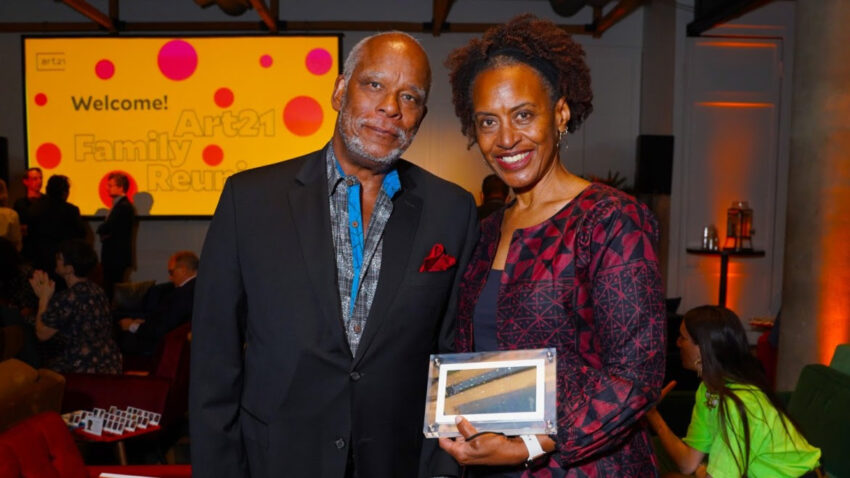
Marcia Smith and Stanley Nelson at the 2022 Art21 Family Reunion. (Courtesy of Art21 and Sean Zanni/PMC)
- “Marcia Smith, co-founder and president of Firelight Media, the nonprofit production company that airs many of its films on public television, plans to step down from the organization,” Julian Wyllie reported May 24 for Current. “Smith will stay at Firelight Media until a successor is chosen. A national search for a new leader will begin this month. Firelight Media, incorporated in 1998, is known as one of the top organizations for nonfiction productions by and about people of color. Smith formally started the company in 2000 with her partner, the filmmaker Stanley Nelson. . . . “
- “Reporters Without Borders said Monday it had “filed its third complaint with the International Criminal Court about Israeli war crimes against journalists, this one asking the prosecutor to investigate crimes against at least nine Palestinian reporters between 15 December and 20 May, as well as, more broadly, the more than 100 journalists that the Israel Defence Forces (IDF) have killed since 7 October in Gaza. . . .”
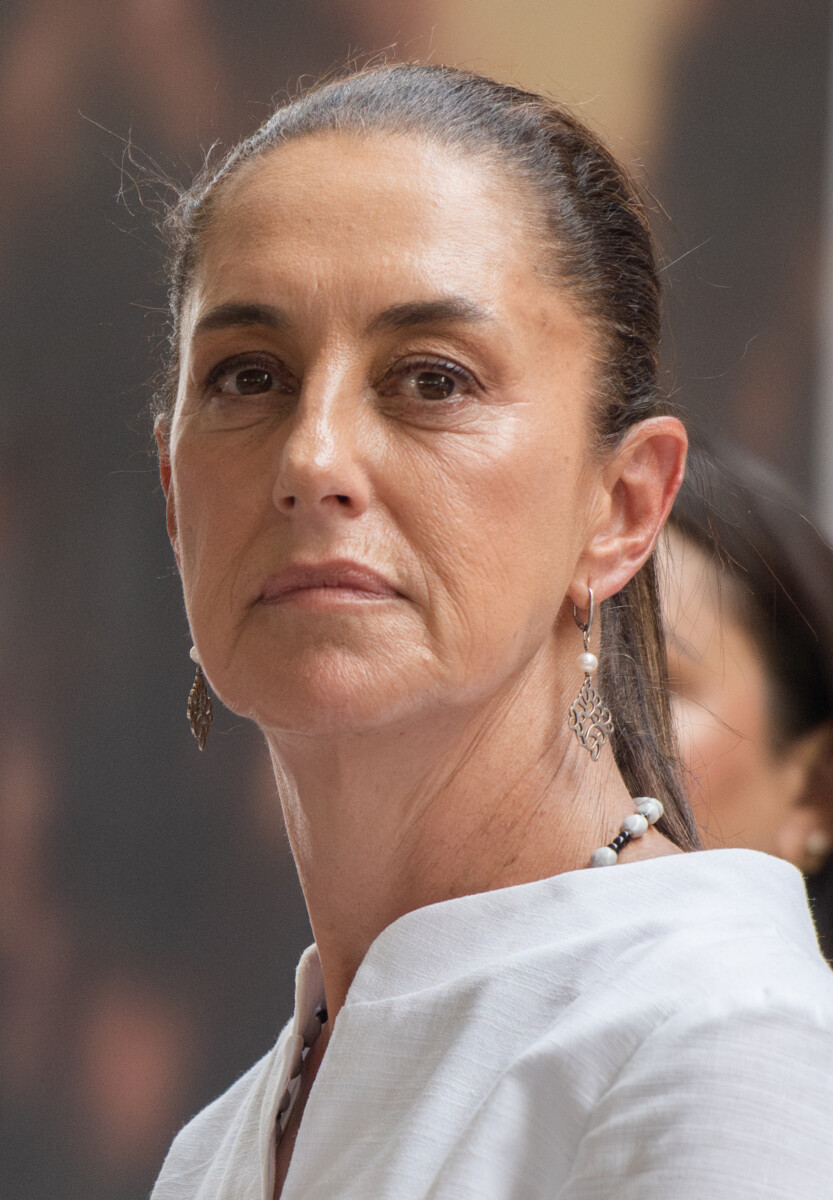 “With less than a week to go to Mexico’s presidential election, Claudia Sheinbaum (pictured), the candidate of the Sigamos Haciendo Historia coalition that includes the ruling Morena party, has given Reporters Without Borders (RSF) a signed pledge to defend press freedom if elected,” the press-freedom organization said Friday. Sheinbaum won the election Sunday, capturing at least 58 percent of the vote and becoming the nation’s first female president.
“With less than a week to go to Mexico’s presidential election, Claudia Sheinbaum (pictured), the candidate of the Sigamos Haciendo Historia coalition that includes the ruling Morena party, has given Reporters Without Borders (RSF) a signed pledge to defend press freedom if elected,” the press-freedom organization said Friday. Sheinbaum won the election Sunday, capturing at least 58 percent of the vote and becoming the nation’s first female president.
 “Nicaraguan journalist Carlos Fernando Chamorro (pictured) received the Golden Pen of Freedom award during the 75th World News Media Congress of the World Association of News Publishers (WAN-IFRA), held in Denmark,” Katherine Pennacchio reported Wednesday for LatAm Journalism Review. “In his speech he mentioned Nicaraguan journalist Victor Ticay, sentenced to 8 years in prison for spreading images of a religious procession on his Facebook account. He also dedicated the award to José Rubén Zamora, director of elPeriódico who is still in prison. To Cuban journalist Mayelín Rodríguez, sentenced to 15 years in prison for disclosing video of protests in Camaguey in 2022. And to Gustavo Gorriti and the IDL-Reporteros team in Peru; the Armando.info team, in Venezuela; and the journalists from El Faro in El Salvador who face criminalization in their countries. . . .”
“Nicaraguan journalist Carlos Fernando Chamorro (pictured) received the Golden Pen of Freedom award during the 75th World News Media Congress of the World Association of News Publishers (WAN-IFRA), held in Denmark,” Katherine Pennacchio reported Wednesday for LatAm Journalism Review. “In his speech he mentioned Nicaraguan journalist Victor Ticay, sentenced to 8 years in prison for spreading images of a religious procession on his Facebook account. He also dedicated the award to José Rubén Zamora, director of elPeriódico who is still in prison. To Cuban journalist Mayelín Rodríguez, sentenced to 15 years in prison for disclosing video of protests in Camaguey in 2022. And to Gustavo Gorriti and the IDL-Reporteros team in Peru; the Armando.info team, in Venezuela; and the journalists from El Faro in El Salvador who face criminalization in their countries. . . .”
- “Relatives were finally able to see human rights activist and journalist Carlos Julio Rojas, 39 days after he was detained,” the Colombian cable news channel NTN24 reported Wednesday. “He is accused of an alleged plot to assassinate [President Nicolás] Maduro at a march in Caracas, Venezuela. Rojas is being held in the maximum security prison El Helicoide, headquarters of the Bolivarian National Intelligence Service (SEBIN, for its acronym in Spanish). After being held in solitary for six weeks ‘Carlos Julio was found to be in an unstable physical condition. His blood pressure is seriously out of control and he has recurrent visits to the bathroom,’ said his spouse, Francy Fernández. . . .”
- “Lesotho authorities should withdraw statements equating media interviews with outlawed music groups to criminal offenses and provide guarantees that journalists will not face arrest for doing their jobs,” the Committee to Protect Journalists said Friday.
To subscribe at no cost, please send an email to journal-isms+subscribe@groups.io and say who you are.
Facebook users: “Like” “Richard Prince’s Journal-isms” on Facebook.
Follow Richard Prince on Twitter @princeeditor
Richard Prince’s Journal-isms originates from Washington. It began in print before most of us knew what the internet was, and it would like to be referred to as a “column.” Any views expressed in the column are those of the person or organization quoted and not those of any other entity. Send tips, comments and concerns to Richard Prince at journal-isms+owner@
View previous columns (after Feb. 13, 2016).
View previous columns (before Feb. 13, 2016)
- Diversity’s Greatest Hits, 2018 (Jan. 4, 2019)
- Book Notes: Is Taking a Knee Really All That? (Dec. 20, 2018)
- Book Notes: Challenging ’45’ and Proudly Telling the Story (Dec. 18, 2018)
- Book Notes: Get Down With the Legends! (Dec. 11, 2018)
- Journalist Richard Prince w/Joe Madison (Sirius XM, April 18, 2018) (podcast)
- Richard Prince (journalist) (Wikipedia entry)
- February 2018 Podcast: Richard “Dick” Prince on the need for newsroom diversity (Gabriel Greschler, Student Press Law Center, Feb. 26, 2018)
- An advocate for diversity in the media is still pressing for representation, (Courtland Milloy, Washington Post, Nov. 28, 2017)
- Morgan Global Journalism Review: Journal-isms Journeys On (Aug. 31, 2017)
- Journal-isms’ Richard Prince Wants Your Ideas (FishbowlDC, Feb. 26, 2016)
- Richard Prince with Charlayne Hunter-Gault, “PBS NewsHour,” “What stagnant diversity means for America’s newsrooms” (Dec. 15, 2015)
- Book Notes: Journalists Follow Their Passions
- Book Notes: Journalists Who Rocked Their World
- Book Notes: Hands Up! Read This!
- Book Notes: New Cosby Bio Looks Like a Best-Seller
- Journo-diversity advocate turns attention to Ezra Klein project (Erik Wemple, Washington Post, March 5, 2014)

